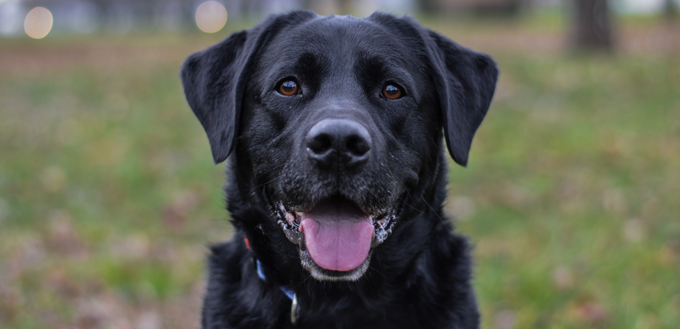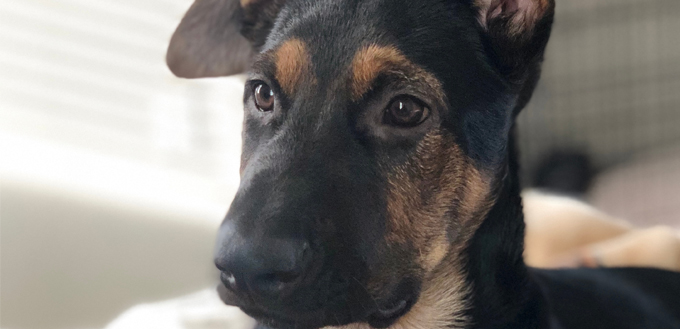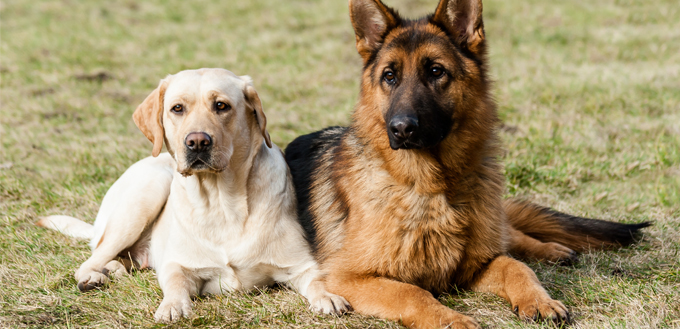Take the US’s most popular dog breed, and cross it with the number two, and you get the Sheprador – a gorgeous looking mix of the Labrador retriever and the German Shepherd. Bringing together these two popular large dog breeds gives you a dog with traits that make them a wonderful pet for the active family. Typically loyal, energetic, intelligent and friendly, the Sheprador wants to be part of your family pack, and so needs a home where they will be at the heart of the action. But they are strong, high energy and can be prone to certain medical conditions, so may not be for every family. To help you decide whether a Sheprador is the right pooch for your home, we’ve put together an in-depth guide to this handsome, attention-loving crossbreed.
History of the German Shepherd Lab Mix
Experts believe the Sheprador has most likely existed for a long time, due to accidental cross breeding to create a hybrid, that was typically considered a mongrel. However, the Sheprador started to be intentionally bred in the 1990s, as part of the growing trend for ‘designer dogs’. The intentional cross-breeding of the Labrador retriever and German Shepherd was also intended to help minimize health problems that often affect purebreds, to create a robust dog that also incorporated the desired traits of both breeds. The result was a desirable crossbreed that could be both fun family pet and watchdog.
The Sheprador is now recognized by both the Dog Registry of America and the International Designer Canine Registry. Also known as the German Sheprador and the Labrashepherd, the majority of German Shepherd Lab mix puppies are first generation cross breeds, meaning they have one parent of each pedigree. This means there can be a wide variation in their looks and coat colors, with no recognized ‘standard’ appearance.
Who are the Parents?
The German Shepherd Lab mix – or the Sheprador – is the result of breeding a first-generation pedigree German Shepherd and Labrador. The Shepherd Lab mix puppy will typically have physical features and characteristics from both its parents, although you could find the genetic influence of one of the pure breed parents is more dominant than the other. So, when considering adding a Shepherd Lab mix puppy to your family, it’s important to understand their two parent breeds:
German Shepherd
The German Shepherd dog – or GSD – was bred to be the ultimate herding dog and today is the US’s second most popular pure breed. The GSD as we know it today dates back to the 1880s and a German cavalry officer called Captain Max Von Stephanitz who wanted to create the perfect herding dog. Driven by a desire to create an intelligent, obedient and agile herding dog, Stephanitz bought a dog that demonstrated these qualities and is believed to be the first dog to be named a German Shepherd. This first GSD’s descendants have gone on to become the pure breed we know today. The German Shepherd – also known by the less widely used name, Alsatian – played a key role as military dogs during both World Wars, and is now a popular choice for service dogs, Police, search and rescue K9s as well as effective guard dogs.
The German Shepherd comes in a range of recognized colors, including black and tan, black and silver, black and red, black and cream as well as solid black. They are considered a large breed and have medium to long fur, which has a thick undercoat.
While they have a reputation for being aggressive, their temperament is actually more alert and wary and so they need early training and socialization to manage their tendency to be over-protective of their family ‘pack’. German Shepherds are strong animals with high energy needs but they also enjoy companionship and are devotedly loyal. The German Shepherd is also intelligent and courageous and with the right training and handling, makes a loving and fun-loving, active pet.
Labrador
The US’s number one dog breed for the past 25 years straight, according to the American Kennel Club, the Labrador – also known as the Labrador Retriever, makes a wonderful family pet. But they were originally bred as a working dog and are descended from the St John’s Water Dogs used by the fishermen in Newfoundland and the Labrador province. The breed worked to retrieve the fish that got away when the nets were retrieved, hence their eventual ‘retriever’ name. The breed was also renowned for its gentle mouth, meaning the fish were not harmed when the Lab carried them. By the 1830s, the Lab had found its way to Europe, where they were used as gun dogs to retrieve a hunter’s kill. Over time, thanks to the Lab’s personality, intelligence and trainability, the breed moved into the home and is now the US’s most favorite breed.
The Labrador retriever is considered a medium to large sized dog, with a shortish, double coat and is recognized in three colors – yellow, chocolate brown and pure black.
So, what about the Lab’s personality and suitability as a family dog? Labs do make excellent pets as they are fun, energetic, and easy to train. Their obedient nature also makes them a good choice for service or support dogs. Labs do need socializing from an early age and can be a little possessive as well as prone to chewing if not sufficiently and consistently trained. Their intelligence means they need plenty of stimulation as well as exercise, making them a good choice for an active family with children who are willing to play as well as love their pet. Labs are also easy-going, and fun loving, making them undeniably one of our favorite dog breeds to own.
German Sheprador Quick Facts
So, now we know a little more about the parents of the German Shepherd and Lab mix, we’ve put together a few quick facts to show what sets this mixed breed dog apart:
- You can never be quite sure what you are going to get when it comes to the Shepherd Lab mix appearance! Some puppies will have the familiar long muzzle and tall, stand-up ears of the German Shepherd, while others will have the squarer head and flop-over ears of the Lab. And that’s the unpredictable beauty of owning a cross breed!
- While a German Shepherd Lab mix can come in a wide range of hues, the main coat colors you can expect with a Sheprador are black, white, red, cream, gray and blue, either in a solid color or a mix. Many Shepradors also inherit the classic saddle back pattern of their GSD parent.
- It is highly likely your Sheprador pup will have a shorter coat like the near fur of their Lab parent. This is due to the fact that the gene for longer fur is recessive and rare in Labradors. So, even if the German Shepherd parent has a very long coat, it is unlikely to passed onto their Sheprador offspring.
- The German Sheprador crossbreed is protective and alert by nature and so brilliant companion and watchdogs.
- A fun fact is that many German Shepherd Lab mixes love to play in snow! And that lovely double coat also helps to actually keep them cool in the summer, so they make great all-seasons family dogs.
- With the combined intelligence of their German Shepherd and Labrador Retriever parents, the Sheprador mixed breed has a high IQ which means they need plenty of mental as well as physical activity and stimulation. Left alone for long periods of time, the Sheprador can become bored, potentially leading to depression and destructive behaviors.
- The Retriever instinct is also strong in Shepradors, meaning they love to carry things in their mouths. So, make sure they have plenty of toys and chews to keep them occupied!
Things You Should Know About Sheprador
As a mixed breed, the life expectancy of Shepradors will typically follow that of its parent breeds, so you can expect a lifespan of between 10 and 14 years. And with the right care and attention, your German Shepherd Lab mix can remain healthy and active well into their senior years. So, if you are considering welcoming this handsome designer breed into your home, there are some key things you need to know about looking after a German Shepherd Lab mix:
Training
When it comes to the German Shepherd Lab mix, there are two dominant natures at play – the assertive character of the German Shepherd and the Lab’s desire to please. And while these characteristics may seem to be opposites, it means that Shepradors will respond well to positive rather than domination training. The GSD side of your Shepherd Lab mix means they will not respond well to punishment or dominance, leading to a potential battle of wills, whereas the Lab character means positive training totally taps into their people pleasing nature.
Your Shepherd and Lab mix puppy will also greatly benefit from early training, as well as socialization as both the German Shepherd and Lab tendencies mean they could benefit from learning how to be comfortable in the company of both strangers and other dogs and pets. And, with early and effective socialization as well as positive obedience training, your Sheprador will make a wonderful family dog.
As well as training, your Sheprador will also need plenty of exercise and playtime to keep that energetic body and mind in check. And the reason the Lab German Shepherd mix works best with an active household is that he is likely to need around two hours of exercise per day, whatever the weather! Without enough exercise, your German Shepherd Labrador mix could be prone to weight gain. However, the Sheprador is a good pet to take on the trail, out running or for a fun game of frisbee so by mixing up their daily walk with games you can get the best of both worlds.
You May Also Like: Frisbee for Dogs
Feeding
The ideal diet for a Lab German Shepherd mix is one formulated for high energy larger breeds, so opt for high-quality protein and fats, with limited quality carbs. Managed portions and a regular feeding schedule are also essential as the food-fiend Sheprador has a tendency to overeat and can be prone to obesity if their meals and treats are not kept in check.
Just like all other breeds and crossbreeds, the Sheprador’s diet will need to adapt, from puppyhood through to their adult and then senior years to ensure they are getting the appropriate nutrition for energy and good health at every life stage.
Some Shepherd Lab mix breeds can also be prone to allergies. If so, look for grain-free or limited ingredient formulas, boosted by probiotics and novel proteins such as venison, lamb or rabbit to keep their digestion happy without irritating the more sensitive dog. You can try mixing food for german shepherds and food for labs, your pooch will surely love it.
Grooming
Thanks to both parent breeds known to be shedders and will ‘blow’ their coat spring and fall, the Sheprador’s coat will need some care and attention. And, as they do shed quite heavily, this cross breed may not be suitable for allergy sufferers.
The fur of the Sheprador is typically neat and mid-length, with a dense, double coat that as long as it is regularly groomed is pretty easy to care for. Out of the ‘blow’ season, a good groom with a bristle brush or comb once or twice a week should be enough, while a daily groom during their coat blow will make life easier for all concerned!
With their dense coat, bathing is recommended every few months, using a mild pet shampoo so you don’t strip out all that essential natural oil in their fur. Other good grooming habits include cleaning their ears and eyes regularly and trimming their nails once or twice a week. And don’t forget their oral hygiene as the Sheprador is prone to tartar build-up, so daily brushing will help to keep their teeth plaque free.
You May Also Like: Dog Toothbrush, Dog Toothpaste, and Dog Ear Cleaner.
Health
While cross breeds, even designer breeds, are widely considered to be hardier than purebreds, the Labrashepherd can still be susceptible to some health problems. Taking into consideration the health of its parents, the German Shepherd and the Labrador Retriever, and that the Sheprador is a larger breed, there are some health issues you need to be aware of:
Hip and Elbow Dysplasia: This is a common condition in many dog breeds which sees the hip or elbow joint not developing sufficiently and so doesn’t fit properly into the joint socket. Over time, this condition can cause pain and eventually arthritis. Larger breeds are particularly susceptible due to rapid growth during the Sheprador puppy stage. In severe cases, surgery may be required.
Progressive Retinal Atrophy: Your German Shepherd Lab mix may also be susceptible to eye issues, including progressive retinal atrophy, an inherited condition that can cause blindness.
Gastric Dilatation Volvulus: Also known as bloat, this condition causes the stomach to dilate and expand, potentially twisting and becoming life-threatening.
Obesity: Without sufficient exercise and proper care over their feeding regime, a German Shepherd Lab cross can overeat, leading to obesity and all the potential health issues associated with an overweight dog.
Degenerative Radiculomyelopathy: Often seen in German Shepherds, this condition affects a dog’s spinal cord, leading to weakness in the hind limbs and eventual paralysis.
Panosteitis: Another condition to affect the limbs, panosteitis is inflammation on the outer surface of the leg bones, leading to lameness and making your pet’s leg vulnerable to breaks.
Underactive Thyroid: Another condition which both parent breeds can be prone to, an underactive thyroid means your dog can’t secret sufficient hormones, leading to lethargy, cold intolerance, coat/skin changes and weight gain.
Temperament
With high energy, a playful personality, intelligence, loyalty and obedience all on their traits list, will a German Shepherd Lab mix make a good family pet? Well, they certainly have the temperament to become a much-loved member of the family but like all breeds, the Sheprador does have its positives and not-so-positives, when it comes to its temperament.
First up, you do get the wariness, confidence and assertiveness of the GSD, which if not managed from an early age can mean your Sheprador could be over-protective. But you do get a super-loyal dog that is extra loving with his special human pack – in short, a canine friend for life. Then there’s the eager to please personality of the Lab, as well as their friendly and outgoing nature. But as with the GSD, the lab traits in your German Shepherd Lab mix means they are highly intelligent and can become destructive, if they are left to get bored.
However, Shepherd Lab mixes are easy to train and have plenty of energy to keep a family entertained, and they will simply love to spend time with you and yours. Early socialization will make sure your Sheprador is good to be around children and other family pets, and don’t forget it’s important to teach youngsters how they should also behave with any dog. For an outdoor loving family that has the time and energy to keep up with their new pup, then Shepradors make fantastic and much-loved family members to welcome into your home.
Is Lab Shepherd Mix Aggressive?
Although the GSD breed may have an unfair reputation for being aggressive, it is not necessarily a cause for concern in your Lab Shepherd mix. Your Sheprador may well show watchful and protective traits but they should not be aggressive, as long as they, like any dog, is trained and socialized consistently from an early age. Plus, you also get the friendly personality of the Labrador Retriever into the mix, making them unlikely to be a cause for concern.
How Much Does a Sheprador Cost?
The price of a Sheprador does depend on where you plan to get your new pet from, either a shelter, private seller or registered breeder. When buying a mix breed such as a Sheprador, try to get to meet the parents if you can.
A Sheprador puppy will cost around $800, although prices can be higher. Rescue dogs will incur an adoption fee, typically between $120-$300 depending on the shelter or adoption center.
How Big Will a German Shepherd Lab Mix Get?
Considering the parents, with a Labrador German Shepherd mix, you are going to get a medium to large family member! As a cross breed there is no standard, but a typical adult male Sheprador will measure between 22 to 27 inches tall, while females come in at between 20 to 25 inches tall. You can also expect your German Shepherd Lab mix to weigh between 55 to 80 pounds when fully grown. And that is a lot of fun, loyal and loving pet for your money!
Sources:
- German Shepherd Dog – The American Kennel Club










